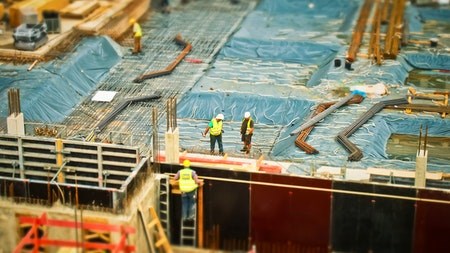As a project owner, you will almost certainly want to have a degree of control to ensure that the project stays on track. If you take on the job of a project manager, it doesn’t necessarily mean that you have to be on-site all day long. It simply means that you are the chief coordinator, ensuring that materials are on-site when needed and that the contractors know when they need to be on-site for specific tasks.
You can also keep an eye on finances to ensure that you don't go over budget, which is always a concern with any construction project.
If you aren't keen on being a project manager, you could either employ one or ask the person doing your plans to project manage the construction for you.
The National Building Regulations site offers detailed guidelines for owner builders.
WATCH : Building a Residential Property Portfolio
Process
If you plan to manage your own home building project, you should have some idea of the construction process. You must also have the time to organise and check on other people.
Any building project entails:
- Drawing up and submitting plans according to the requirements of the local authority and National Building Regulations.
- Using the plans to compile a schedule of finishes
- Costing and quantifying materials and labour according to the schedule of finishes.
- Establishing a construction schedule.
- Overseeing construction or ensuring a trusted person involved in the project oversees construction.
- Contacting the local authority at different stages of the project to check on the progress.
- You will need to notify the bank if you have a building bond to be able to make withdraws at various stages of the building project.
NHBRC
.Because you are owner-building, you will need to apply for an exemption from enrolling your house with the National Home Building Registration Council (NHBRC).
The Housing Consumers Protection Measures Act (as amended in 2007) terms an owner-builder as:
- a person who builds a home by himself for occupation, or
- a person who is not a home builder registered with the NHBRC and assists someone in building a home for his own occupation.
Initially, the Act was promulgated in 1998 and stated that all home builders had to register with the NHBRC. However, it did not specifically address the status of owner-builders, who are not generally in the business of building homes. This became a legal loophole.
It also became an issue with some banks, which refused to approve mortgage bonds unless a registered builder was in charge of construction. This can still be an issue with some banks, even though the law now allows owner builders to apply for NHBRC exemption.
Note that:
- The NHBRC requires owner builders to retain property ownership for at least five years. You will need to provide a copy of the title deed to prove ownership.
- Suppose you are not the property owner and will only be assisting the owner in building their home. In that case, you will need to provide the title deed and a power of attorney authorising you to apply for exemption and to build the house on his behalf.
- If you want to owner build and be your own project manager, you will need to complete a short multi-choice exam with the NHBRC to prove that you have adequate building knowledge. If not, you will be obliged to appoint an approved project manager.
Plans
In terms of the National Building Regulations, a competent person - usually an architect, an architectural designer or a draughtsperson must draw up plans and apply to build to the local authority.
As a project manager, you will need to work very closely with the person you appoint. You need to be sure of the exact role your competent person will play from the start. This will determine the degree of responsibility this person takes on and their fee.
Materials
Whoever you appoint as the official competent person on-site will specify (in consultation with you) the materials that should be used for building, these will include everything from the bricks or blocks to be used to finishes like plaster and paint.
In addition to what is shown on the plans and working drawings, a schedule of finishes should include every item to be used in the construction. This includes ironmongery, taps and other bathroom fittings, cabinets to be fitted in bathrooms and kitchens and cupboards in bedrooms.
The more detailed the schedule of finishes, the more accurate the quantifying and costing for the project will be.
Costing
Quantity surveyors are trained to quantify and cost building projects accurately. In addition, professional project managers and companies that offer various computerised services for the construction industry also provide this service.
However, owner builders can easily carry out these estimates either manually or on a computer, using the following guidelines:
- Avoid working on a cost per square metre. Although it will give you some idea of what size of house you can afford to build, your calculations won’t be accurate enough for working out costs.
- With materials like concrete, bricks and mortar, you will need to estimate according to surface areas and depth. The Owner Building in South Africa manual has some useful tables for calculating how many bricks or blocks per square metre, the volume of mortar you will need, and estimating plaster requirements.
- Always get two or three quotes when you cost materials, and check availability. If there is a delivery charge for items, include this in the budget.
- Remember to cost in items like plant hire, storage sheds, site toilets and utility connection fees.
- According to the general rates paid in your area, you also need to cost labour in the equation. These should be at least the minimum wage specified by law, as defined in the Basic Conditions of Employment Act, available online.
Construction schedule
The construction schedule probably requires the most coordination. Although the sequence of activities may seem obvious, many individual tasks overlap from setting out to completion. For instance, the electrician could complete the wiring while the roof is being tiled. As a project manager, you need to know precisely who must be on-site and when.
- You will also have to monitor progress, and at various points, the local authority will need to inspect the site. If a site visit with the municipality is not timeously arranged, the whole schedule can be thrown out because you won't be able to start on the next step until you get official approval.
- If there are delays, you need to take immediate action to ensure that future activities won’t be affected. For instance, if the glass for windows has been ordered for a specific date, but the brickwork has not been completed, you need to change the delivery date.
Project managing the building process of your own home can be very rewarding, but it is not for the faint-hearted. If you have doubts about your capabilities, it is probably best to employ a professional to do the job.
Writer : Sarah-Jane Meyer





